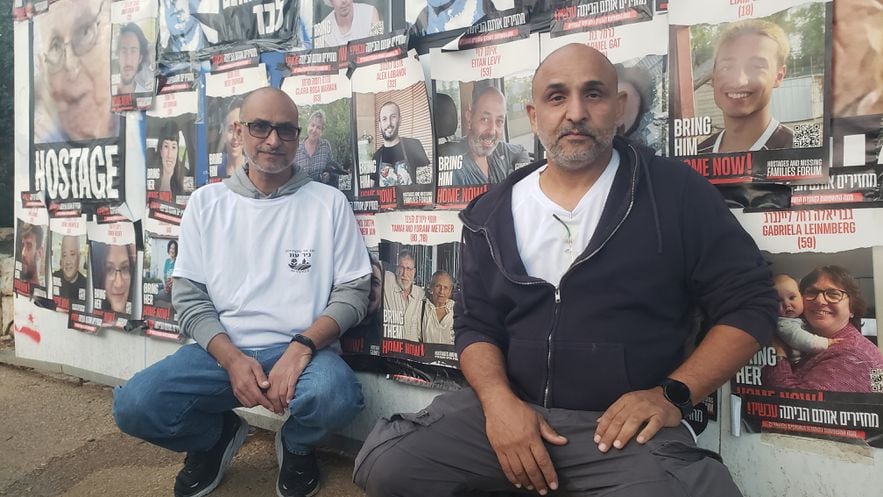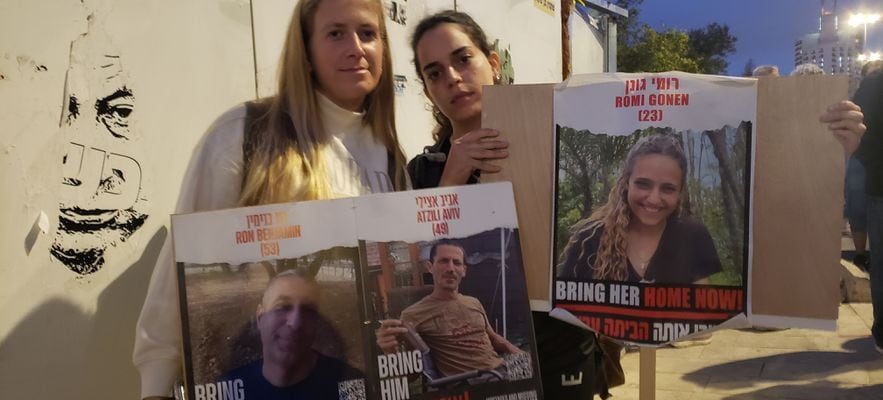As soon as you set foot in Israel, the first image takes your breath away. In Ben Gurion International Airport, deserted by its 80,000 daily travelers, a guard of honor awaits the few international visitors: on a 600-meter aisle, rows of photos of the 239 hostages captured by Hamas on October 7, with their name, their hometown and a single message: “Bring them home”. A little blonde girl nods between the faces of Agam Goldstein, a 17-year-old teenager kidnapped from her home with her two little brothers, or of Maya Goren, 56, whose husband was killed during the attack. Only a word from her father prevents the little girl from kissing the posters, which she caresses one by one.
“These hostages are the cloud that will remain above our heads for a very long time,” Michael muses aloud, on the terrace of a Jerusalem café. The fifty-year-old, with a white yarmulke on his hair, thinks back to Gilad Shalit, this Israeli soldier held for five years by Hamas, from 2006 to 2011. “At the time, the whole country suffered on a daily basis with him,” recalls Michael. a single hostage, it was a national ordeal, the televisions talked about it every day. So today, more than 200 people… I don’t know an Israeli who doesn’t think every day about their suffering, their fear.”
Netanyahu at the center of criticism
According to those close to the hostages, one man in Israel has not had these victims sufficiently in mind since October 7: Prime Minister Benjamin Netanyahu. So they took over Jerusalem’s power district, setting up their stands halfway between the Knesset, the Supreme Court and the Prime Minister’s residence. Here, all the walls are covered with photos of the hostages and stickers displaying Netanyahu’s face covered with a bloody handprint.
Armed with a huge roll of tape in one hand and an Israeli flag larger than her in the other, Ofra Rozman, 73, glues together the posters damaged by 42 days of waiting one by one. “I hate to see them degraded, they are our children!”, motivates this grandmother, whose three granddaughters are involved in the army. For each hostage whose poster she repairs, Ofra has a little story. “This one is a Filipino worker, can you imagine coming to work so far from home and ending up in this hell?”
She stops in front of the portrait of Noa Marciano, an Israeli soldier captured on October 7 and whose body was found near al-Chifa hospital in Gaza earlier this week. She was 19 years old. “What sadness for Israel,” breathes Ofra, touching the photo of the young soldier. And the worst thing is that there is no one with whom to negotiate. Opposite, there are only terrorists, no one hope.” At her side, her husband, Izac, adds: “I don’t know if our government can do anything for the hostages, but the result is there: after 42 days, they obtained nothing. They bombed, they killed, but the situation has not changed.”
The two septuagenarians do not directly know any hostages in Gaza, but they came from Kfar Saba, north of Tel Aviv, to support families without news of their loved ones. “When more than 200 people are kidnapped in a country of nine million inhabitants, it is inconceivable,” explains Ofra. “We all know someone whose loved one is being held in Gaza. Israel is like a big family.”
The march of the families of the hostages towards Jerusalem
This Saturday, November 18, several thousand people flocked to Jerusalem, to Benjamin Netanyahu’s office. Five days ago, the families of the hostages launched a large march from Tel Aviv to reach the capital and put pressure on the government, so that the return of their loved ones becomes the priority of the authorities. Walking along the roads, sleeping in tents, their pilgrimage was followed by the entire country.
With his backpack and a second pair of sneakers on his shoulders, Noy Sharf has to sit on a rock when arriving in front of the Knesset in Jerusalem. The 25-year-old young woman, a psychology student, took advantage of the closure of her university in northern Israel to join the march of the hostages’ families. In her hand she holds a sign with the face of one of her best friends, Romi Gonen, whose smile in the photo contrasts with Noy’s somber face. “She is an intensely happy girl, always laughing and partying,” describes the walker. “Hamas captured her during the Negev rave party and we have had absolutely no news since. I think about it every day , every minute, every moment.”
Noy Sharf (left) participated in the march for the release of the hostages, between Tel Aviv and Jerusalem, on November 18, 2023.
© / The Express
Behind her, the crowd gathered around a podium. At the podium, relatives of the hostages recount their ordeal, that of their family, and demand explanations from the government. The speeches are interrupted by thousands of demonstrators chanting “achshav” – “now” in Hebrew. They all say that, since October 7, the authorities have communicated nothing to them, not even support. “In 42 days, the Prime Minister has not found the time to speak to the relatives of the hostages, to meet them,” storms Yael Vardi, a little brunette from Tel Aviv, whose 77-year-old friend finds herself a prisoner in the gang. of Gaza. Netanyahu says our first mission is to destroy Hamas, then bring back the hostages. But it should be the other way around! Hostages first! And then we can continue the war…”
In the crowd of marchers, the anger against Netanyahu and his ministers is unanimous. Only a handful of “pro-Bibi” came to challenge the criticism aimed at the Prime Minister, increasing tension in the assembly. Faced with this scene, Ran Metzger shakes his head. “When there is war in Israel, everyone expects flawless unity and silence, says this logistics consultant. But on the contrary, it is the time to shout, it is time to have leaders we can trust.” He is demanding Netanyahu’s immediate departure and has set up his bed in the street, in front of the Prime Minister’s office for three days, with his brother Gug. “We will return home when Netanyahu returns home,” adds the latter. The parents of the two brothers were kidnapped by Hamas on October 7.

Gug and Ran Metzger, whose two parents are hostages of Hamas in Gaza, during a rally in front of the Knesset, in Jerusalem, November 18, 2023.
© / The Express
Aged 80 and 78 respectively, Tamar and Yoram had been living in the Nir Oz kibbutz, on the edge of the Gaza Strip, since 1974, when it was attacked. He, a former vice-president of a large paint company, continued to cook for the village’s families. She, a retired teacher, is sick and can barely walk, according to her two sons. Since October 7, Ran and Gug have only received news of their parents once, from one of the hostages released by Hamas. “She lived with them for two weeks, in underground cells,” says Ran Metzger. “All we know is that they arrived in Gaza in one piece, that they were fed and were able to see a doctor. On the other hand, they have had no outside light for 42 days. Every day they spend in captivity increases the probability of never seeing them again.” Only four hostages were released by Hamas, including two American women, and another was freed by the Israeli army. Several were found dead.
Saturday evening, after the dispersal of the big march of families, Benjamin Netanyahu addressed them, but only during a press conference. His message: “We walk with you […] and when there is something to say, we will tell you.”
.
